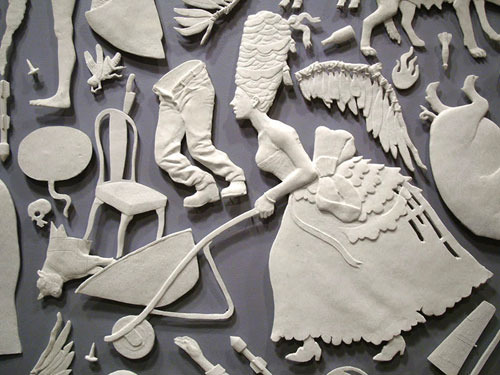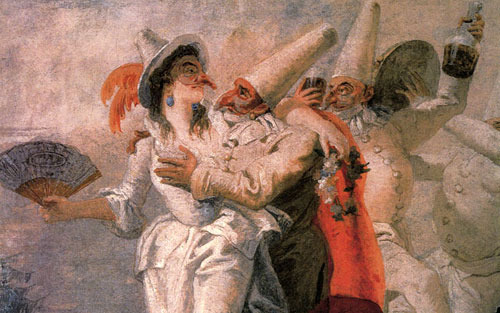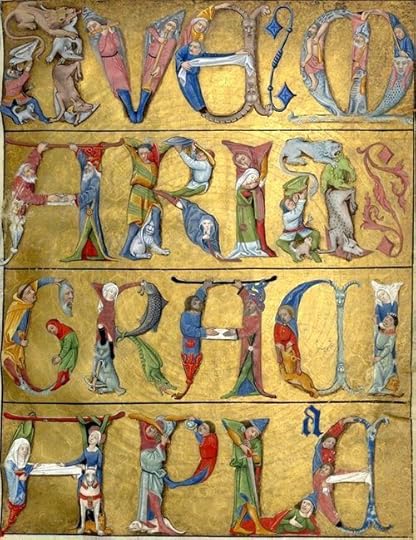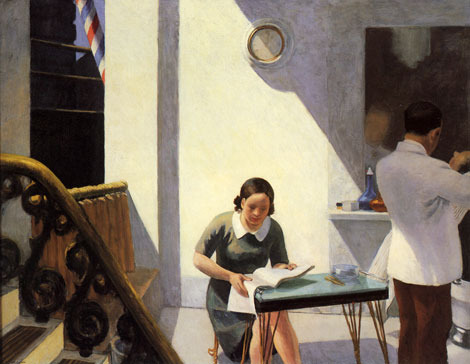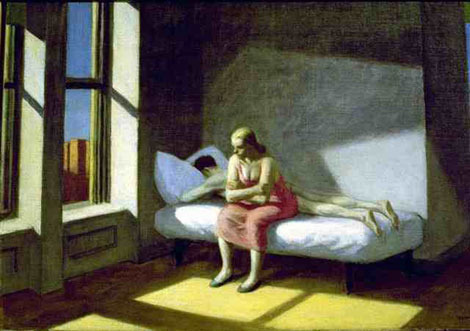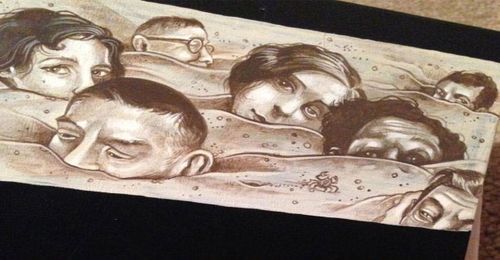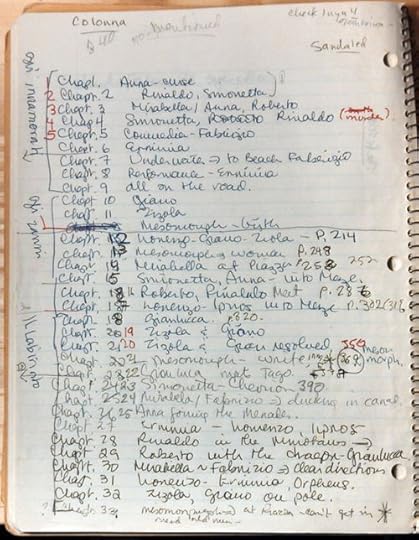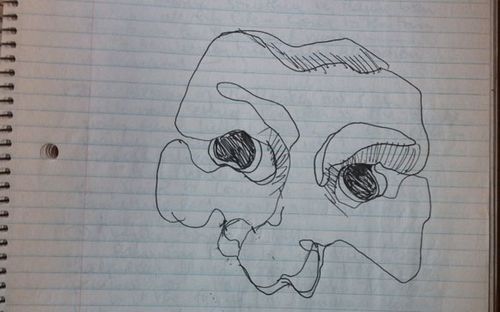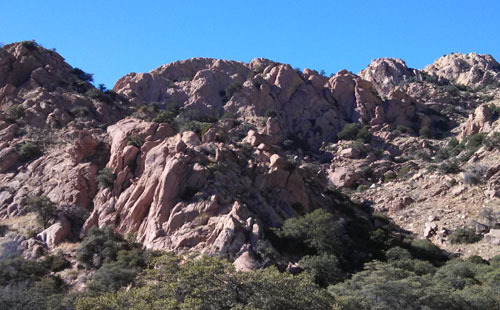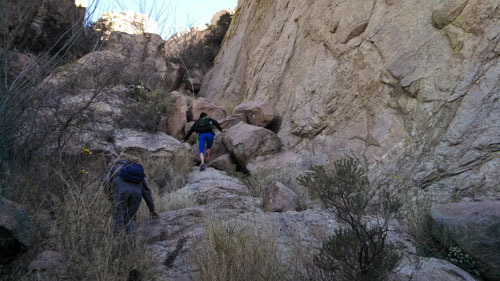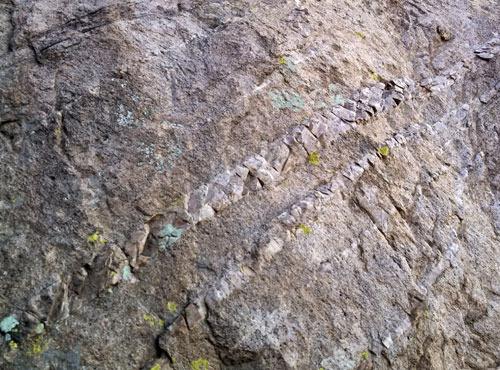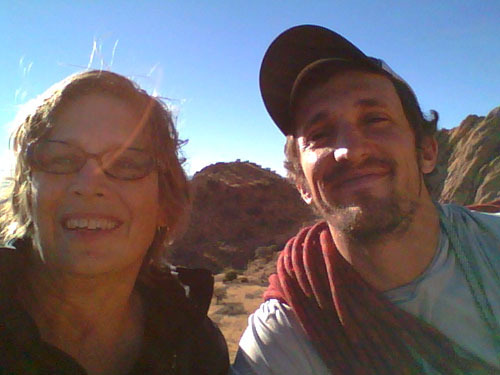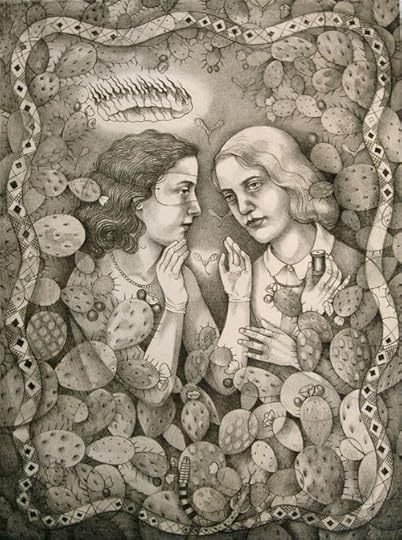Midori Snyder's Blog, page 51
January 13, 2014
Drunk Hiking on a Sunday.
(Bunny Cactus Shadow)
Well, sort of drunk hiking...we were cold sober on the three hour hike going up the Rincon Mts from 2,700ft to 5,200 ft -- something we had not quite intended to do, but the day was beautiful, the mountains fresh and lovely and so we didn't stop until our legs complained too loudly. We rested on sun-warmed rocks, ate three homemade molasses cookies and drank a flask of Jack Daniels. And almost immediately due to the altitude and lack of food felt absolutely giddy. It was a lot of fun.
Even the three hour hike down was a bit like stumbling on ship in storm, laughing at everything, and feeling very "friendly" to the few intrepid hikers we met. Back home there was a general collapse, aspirin for sore feet and muscles, followed by an immediate promise to go again soon.
January 10, 2014
Rounding Up the Week's Internet Delights.
So many wonderful internet offerings this week. Here's my happy list:
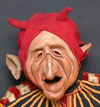 Band of Wild Petticoats provides two posts ( here and here ) on 18th century Brazilian-Portuguese playright Antônio José da Silva, and his dangerously seditious stories;Obras do diabinho da mão furada, roughly translated as: Tales of the devil with the pierced hand. Hold on to your hats -- it's a brawl.
Band of Wild Petticoats provides two posts ( here and here ) on 18th century Brazilian-Portuguese playright Antônio José da Silva, and his dangerously seditious stories;Obras do diabinho da mão furada, roughly translated as: Tales of the devil with the pierced hand. Hold on to your hats -- it's a brawl.
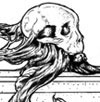 The Fall, 2013 Issue of Goblin Fruit has a terrific poem by Lynette Mejia, "As Above, So Below" which you can both read in text and listen to the poet read her work. Mejia gives a wonderful reading -- well worth putting your head phones on for this one.
The Fall, 2013 Issue of Goblin Fruit has a terrific poem by Lynette Mejia, "As Above, So Below" which you can both read in text and listen to the poet read her work. Mejia gives a wonderful reading -- well worth putting your head phones on for this one.
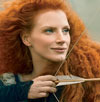 Once Upon A Blog gives us a peek into Annie Leibovitz's photo shoot of Disney heroine "Merida" and an introduction to a real life Merida -- red-haired Virginia Hankins, stunt woman and archer. As always, Once Upon a Blog provides the best posts on what's happening with fairy tales in the media.
Once Upon A Blog gives us a peek into Annie Leibovitz's photo shoot of Disney heroine "Merida" and an introduction to a real life Merida -- red-haired Virginia Hankins, stunt woman and archer. As always, Once Upon a Blog provides the best posts on what's happening with fairy tales in the media.
 Junk Head I : An animated horror (light horror -- some monster chomping) film created over the last four years by a single artist/film maker, Takahide Hori. You can read all about how he made the film (and consider helping him out with some funding for the sequel) here at Kotaku. Couldn't take my eyes off of it -- very Burton-eques.
Junk Head I : An animated horror (light horror -- some monster chomping) film created over the last four years by a single artist/film maker, Takahide Hori. You can read all about how he made the film (and consider helping him out with some funding for the sequel) here at Kotaku. Couldn't take my eyes off of it -- very Burton-eques.
 And if you haven't seen the The Appendix -- a very interstitial quarterly journal of experimental and narrative history -- stop by their blog and marvel at all the jewels out there on the internet in their "Weekly Reading" sections along with the Journal's own excellent articles in the current issue.
And if you haven't seen the The Appendix -- a very interstitial quarterly journal of experimental and narrative history -- stop by their blog and marvel at all the jewels out there on the internet in their "Weekly Reading" sections along with the Journal's own excellent articles in the current issue.
Jedidiah Morfit: Extraordinary Sculptures
New Jersey sculptor Jed Morfit creates incredibly large and intricate bas-relief friezes from small detailed pieces shaped and molded out of plastic. At first glance the total piece is captivating -- almost fun in a child-like way. But the work demands a closer examination, and then one begins to see the tension -- the "anxiety" Morfit says, much like in a Brueghel painting with all of its beautiful small scenes depicting hellish events, for example in the section below with its interesting juxtaposition of a very pregnant woman and upside fairy tale crone, and arrows shooting into a casket amidst what feels like a very lively and active scene -- characters running, shouting, a scattering of wings and bones, shopping carts and wheelbarrows all moving at once.
Here is a short video from State of the Arts of Morfit talking about his work and the process of creating these intricate and elaborate works of art -- and I am especially fond of the last piece in the video of a larger than life woman fencer with a deeply wooded and leafed forest as her skirts. (Here's the almost finished work "Mama's in the Arbor".) You can see a lot more of his work over at If It's Hip, It's Here. Gorgeous stuff.
January 9, 2014
A Chorus of Clowns Redux
I spent the morning revising a bit and adding more art to "A Chorus of Clowns and Masked Comic Theater," an article I wrote long ago for the "Folkroots Column" in Realms of Fantasy and then republished the Journal of Mythic Arts. I had almost forgotten how interesting it was (well...to me at least) reaching back to see the long lineage of theatrical clowns from the Greek Satyr plays, to the Roman Atellan Farces, to the Italian Commedia dell' Arte, and finally to the Marx Brothers who remain unparalleled in our culture for that fast cracking wit and hilarity. Here's a bit from the end:
"The chorus of clowns rips apart polite society and in that act exposes our true feelings. In this joyful disorder, we remember primal emotions: we lust, we become envious and jealous, we are starved for affection and fame, and we long for an illusive, trouble–free happiness. We would rather sleep than work; we are clever and undeniably foolish at times. We are complicated, conflicted, and no single character can carry the weight of so many inconsistencies. We need a chorus of clowns to speak for us. Despite their secular natures, the clowns are still mythic to me. Humor is an old response to fear of the unknown and contempt for the familiar. For 3,000 years, somewhere a chorus of clowns has misbehaved, and in their audacity, called down gods, heroes, and legends for a face to face meeting with humanity, offering laughter as a form of reverence."
Art: "Pulcinella in Love" Giovanni Domenico Tiepolo (1727–1804)
January 8, 2014
Life in Letters: A Calligrapher's Narrative
How stunning is this? The text reads "Ave Maria Gratia Plena" -- "Hail Mary Full of Grace." But within the confines of each letter, the calligrapher depicts individual narratives creating tension between the two -- the formality of the letters joined into sacred text and the liveliness of the people and animals engaged in very human and fantastic activities. An unstoppable redeemed creation -- with all its beauty and faults, love and violence, domestic and wild nature praising Mary the Mother of God. (Click on the image for a larger version)
Heure de Charles d’Angoulême. Horae ad usum Parisiensem. Latin 1173. 1485. (source: Bibliothèque nationale de France). And if you want to see the entire manuscript (praise be for the digital age!) go here "Horae ad usum Parisiensem" and scroll through the pages.
Here is a bit more about the work and the artist from a publisher that specializes in creating reproductions of these beautiful manuscripts.
"This book of hours commissioned for Charles, Count of Angoulême (the father of Francis I of France) is undeniably Robinet Testard’s most personal work. Testard, one of France’s most creative painters, drew upon his boundless imagination to create a totally novel work. The calendar scenes on the opening pages are surprisingly original. Testard also portrays exotic landscapes, botanical elements, an acrostic featuring animated figures more typical of alphabet books, and even combines mythology and religion in rather peculiar ways. Testard’s compositions in the Passion cycle are inspired by engraving techniques, and the intense, vivid colours in his paintings bring the scenes alive."
January 7, 2014
Old Bones, New Tales
This is an odd moment. Three book ideas I have been working on lately have suddenly come into clarity as a single cloth -- not as a trilogy mind you, for each is different enough from the other -- but organically they seem to spring from the same desire to write about early, middle, and late life. I feel as though on any given day, I could write in all three manuscripts without missing a beat. Two at least are set in Italy (thank god the research here helps both novels). The third is contemporary fantasy, so familiar ground.
I turned 60 on January 1st of this year and I think this huge meta-thinking about the novels has a lot to do with my age. When studying African oral narratives I learned that women story tellers in South Africa (and probably in every traditional society) told the same stories (with some changes in emphasis depending on the audience) to all different ages -- sometimes the audience was a mixture of ages and the tales were meant to be entertaining and to introduce the very young to the artistry of story-telling. Other times it was intended for a specific audience such as young women going through rites of initiation, and there the same stories acquired an instructional emphasis, the tales focusing on transformation to adulthood.
But older women also performed those same stories privately to each other. All of them so well versed in a life time of living and of telling those tales. They knew these stories intimately -- and in those variants they told to each other, there is depth and nuance in the performances. It was an opportunity for them to reflect and to comment through mature and evocative perfomances of the tales on their own past rites; their lives as young women, as wives or co-wives, as mothers, and now as elders. One of the great Xhosa story tellers Nongenile Masithathu Zenani towards the end of her life performed three, one-hundred-hour epics. Each epic was performed over about 21 days --with Masithathu speaking for 5 to 6 hours each day. And like Scheherazade, each morning picking up the tale where she left off the night before. The epics were composed from the threads of the oral narrative stories she had learned and told throughout her life, entertwined with a wealth of cultural details and a social history of the Xhosa. (I am still waiting to read one day the final translation of these three epics which were recorded and transcribed by Professor Emeritus Harold Scheub.)
As authors, we continue to reach back into the deep well of inherited stories -- the universality of rites of passage means every generation will want to hear them, read them, and connect to them. But unlike traditional society where the oral narratives and epics could be learned at the knee and then repeated (though different variants even within a culture suggest personal embellishment and emphasis in the telling), modern authors are always required to reinvent old tales and make them "fresh" -- sometimes with wonderful results and sometimes with stunningly bad ones. (I can never get over the dreadful Beowulf movies...Beowulf in Space, Beowulf with a Golden Stiletto-Heeled Monster mother).
So I guess this is the big challenge now for me. Trying to be faithful the tales, to take the time to reflect on how they have shaped and articulated different moments in my life, and yet, satisfy the craving to create something new, something "fresh" out of very old but venerable bones.
For more reading:
* Life Histories of African Women, edited by Patricia W. Romero which contains the autobiography of Nongenile Masithathu Zenani recorded, transcribed, and translated by Harlod Schueb.
**The Word and the World: Tales and Observations from the Xhosa Oral Tradtion. "A master storyteller of the Xhosa people of South Africa, Nongenile Masithathu Zenani gives us an unprecedented view of an oral society from within. Twenty-four of her complex and beautiful tales about birth, puberty, marriage, and work, as told to the renowned collector of African oral tradition, Harold Scheub, are gathered here. Accompanying the stories are Zenani’s detailed commentaries and analyses and Scheub’s striking photographs of her in performance. The combination of these historical and cultural observations with a richly symbolic collection of tales from a single traditional storyteller make The World and the Word a remarkable document."
Art: Edward Hopper: In the Barber Shop, 11:00AM, Summer in the City
January 6, 2014
I Need To Stand Up Straighter
Especially when I write. The ciagrette is a dramatic touch too. Honestly, forget the bunny slippers, last night's t-shirt, and sleepy face washed out in the blue light of the computer screen. This look is to die for and even if the novel doesn't sell...well, I would still be awesome.
 *with apologies and much admiration to the great Maria Callas.
*with apologies and much admiration to the great Maria Callas.
Notebooks and Skeletons: Where the Novel Takes Shape
I am a huge fan of illustrator and graphic design artist Mica Angela Hendricks who has a terrific blog The Busy Mockingbird where she shares not only her work, but also the lovely collaborations she does with her very young daughter (a recent post of their team work went viral not too long ago). She has a new post up now about her sketchbooks and the ritual she has of creating a pleasing cover first as a way of inspiring her to embrace the sketchbook and work. It's a quirky and very funny piece (with lots of gorgeous and spontaneous art from her sketchbooks). However, if the cover isn't right -- she can't keep the sketchbook because the failed cover seems to intimidate her, suggest her work might not be worthwhile after all.
As a writer, I don't have anything as beautiful as a sketchbook of lovely doodles and designs promising much grander moments in the future. I have only spiral college notebooks filled with research notes, the occasional outburst of plot ideas, maybe a badly done drawing, library call numbers, book titles I probably will never get to but like the comfort of having "just in case," sometimes character studies, lists of vocabulary words, and even the entire list of chapters with a one line description to remind me of where I have been, where I am at the moment, and when I am done, the architecture of the whole novel. (Below is an early version of the whole outline of The Innamorati -- looks like I am still rearranging things!)
I have terrible handwriting--big loopy letters, "n"s and "r"s look alike, "u"s and "m"s could easily swap places. I write like my French grandmother, maybe because as a child the most handwritten letters I received came from her and I must have decided that I wanted to create text like that too. As I grew older it turned out I was the only one in the family who could decipher my grandmother's handwriting and was called upon to read all the Christmas or birthday cards (always loaded with a check) she would send to each one of us.
And while it seems pedestrian to use a plain university spiral bound notebook, I am not without my own "specs" when it comes to selection. Narrow ruled is a must. The spiral needs to be small and tight so as not to catch on things in my backpack and unwind. The paper needs to have a certain "crunch" to it. Some paper is so polished, the pen slithers around on it and my writing gets even more distorted than usual. Paper with a crunch is sort of porous, the pen tip bites the rougher surface and the ink settles in deeply. It feels and sounds wonderful to write on it. And yes -- the right pen! I love Pilots -- black and medium. The point is hard and narrow, but the ink flows smoothly into the paper. And it stays dark and legible, even after the paper has weathered. (And all my early notebooks are looking very ancient!).
Every novel I write begins with the right notebook and the right pen. Not to write the novel in, but to sketch its skeleton, its history, its vocabulary, the names, and threads between one idea and the next, one chapter and the next. I will head out this afternoon to select two new ones at the university bookstore, grab a box of new pens, and head to the library with a stack of call numbers. It's going to be a fun year of work.
January 2, 2014
Spending New Years Day In The Wild
New Years is my birthday and it was wonderful to be able to spend it with my family for the entire day hiking and rock climbing in the Cochise Stronghold of the Dragoon Mountains in Arizona. The rugged beauty of the place belies the violence of its history as a site of continuing battles between Apaches and US and Mexican soldiers during the Apache Wars of the late 1800s. The granite faces of the high escarpments make this a rock climbers' paradise -- though most of the climbs are pretty daunting to a novice like me. In some places the rock is a beautiful pink granite laced over with bright green and blue lichen, or deeply etched with crystal veins that sometimes look like prehistorical teeth, other times like a jeweled necklace.
The "trail" seemed more of a suggestion with a fair amount of scrambling over rocks, avoiding getting skewered or scraped by various catci and heavily thorned trees, along with the threat of slippery scree under the feet. But the effort was so worth it -- for the vistas were exhilarating, the air so clean and crisp at 5,000 feet, and the sky a deep clean and spotless blue. Plus there's nothing like the high of adrenaline when you have survived a scary scramble up a rock face to peer over the edge into the valley below.
This is looking up at the trail -- that grove in the mountain side.
The Castle above us.
Crystal veins in the rock face.
Dragon's teeth on the path...felt like stepping on a trap!
My son and I on a break at the summit of a small climb.
December 31, 2013
On the Eve of a New Year
Seven years ago I moved from the Midwest to Arizona, largely prodded by my closest friend Terri Windling who was living here at the time. And how could I have known how prophetic and utterly true and beautiful would be this poem "Dear Sister" from Lisa Cihlar. Here's a few lines that reverberate the strongest:
"...There are other sharp and poisonous things to consider. And road runners which are neither prickly nor poisonous and their feet are zygodactyl, which means two toes point forward, and two point backward. They may be coming or going. If you must go to live in the desert, leaving this moist land where skin ages much better, please accept my gift of leather gloves. The sun alone is enough punishment for the things you have done."
As I begin my eighth year in this dry desert where mountains and monsoons temper the sun's punishment, I gratefully look forward to a new year of thorns and sweetness, of writing and rewriting, of family and more family, of friends and better health. I wish everyone a joyful New Year's Eve and all best wishes for the coming year.
About the Art: This image above is "The Cactus Wren" a piece in Kathryn Polk's gorgeous "Women of the West Portfolio." Do stop by her wonderful blog Non-Indigenous Woman which chronicles her work as an artist.
Midori Snyder's Blog
- Midori Snyder's profile
- 87 followers




